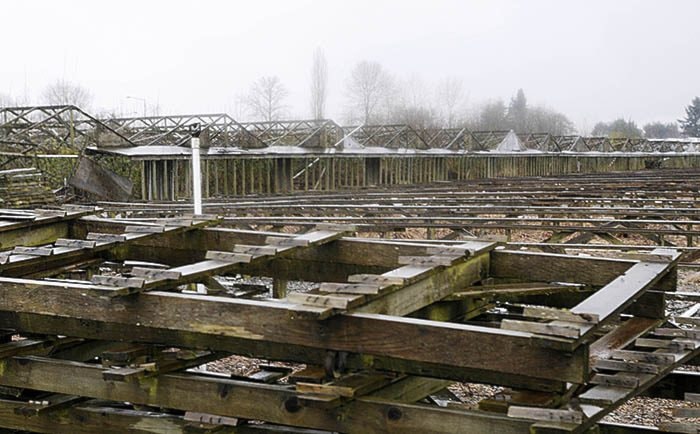Last Saturday, I attended the open house held by the Golden Eagle Farm Group relating to a proposal to remove 56 of 202 acres of land from the Agriculture Land Reserve.
The property in question was former the site of Pelton Reforestation, at the corner of Golden Ears Way and 203rd Street in Maple Ridge.
Golden Eagle would replace the 56 acres taken out of the ALR with a parcel of land the same size in Pitt Meadows, seven kilometers away near Sheridan Hill.
Maple Ridge council would have to endorse and forward the exclusion application to the Agriculture Land Commission.
As I walked into the building on the site that housed the display boards and the consultants for the applicant, part of the Golden Eagle Group, a subsidiary of the Aquilini Investment Group, I was struck by a feeling of déjà vu, which I am sure was shared by the familiar faces there that have protested the two previous attempts at having portions of these lands removed from the ALR.
Although I was not there to protest, I certainly was interested in seeing what was being proposed, especially in the form of supports for farming, which the Maple Ridge farming community desperately needs. Especially if we expect our local farmers to be able to contribute to providing locally grown food in a substantive way, because in recent history that has not been the case.
A 2011 Ministry of Agriculture review of farming in Metro Vancouver exposed the fact that only 50 per cent of farm land in the Metro Region is actually farmed.
Maple Ridge is cited as only farming 26 per cent of its ALR lands, and according to Maple Ridge’s Agriculture Plan, one quarter of that is used for growing hay for horses.
The Maple Ridge Agriculture Plan further cites that the majority of farmers are of part-time status, with 70 per cent earning less than $25,000 annually.
This is hardly a livable wage, especially if you take into account the efforts that a farmer must go through to cover the associated costs of a highly regulated industry.
I was once told by a local greenhouse operator that every time another federal or provincial regulation was placed on the industry, and it happened often, it came with an operational price tag of upwards of $10,000, due to required inspections or added equipment.
Those costs cannot be added to the price tag of, say, a head of lettuce, because that same lettuce can already come from California for half the price.
Therefore, the only choice local farmers have is to expand their market, which requires a commercialized operation.
I doubt most of our part-time farmers have the funds to compete in that environment. Yet time and again, we hear people declare their support for farmland and locally grown food, never fully understanding what the farmer is contending with.
In no way does this mean that I believe farms should be sold off and removed from the ALR.
Subdivisions now cover what was once farmland in Maple Ridge, such as my neighbourhood that surrounds Laity View elementary.
Sadly, prior to the Agriculture Land Reserve being set up in 1973, selling off farmland was the trend throughout the suburbs of Vancouver, which, along with increased importation of fruits and vegetables, caused suburbs like Maple Ridge to transform from farming communities that were complete with processing plants and slaughter houses to minimal farming operations and lost distribution infrastructure.
Fast forward to today and the emergence of the ‘buy local’ trend, and we find farmers in Maple Ridge are wanting to respond, but are struggling to do so, as they still face having no local infrastructure that supports their distribution needs and no funds to invest in that amount of required capital at an individual level.
Further, at the same time that the public is insisting on protecting farmland and locally grown food, we happily shop for the lowest priced avocados, mangos and every other imported fruit and vegetable offered by the food retail giants – stores that our smaller, local farmers cannot access.
Lucky for us that we have such a vibrant farmers’ market in our community. However, even the farmers’ market understands that more needs to be done to support the farmers in their quest to reach a broader market than what the two markets can provide during the growing season on Saturdays in Maple Ridge and Thursday evenings in Port Coquitlam.
So while we should all understand the need to protect farmland, it is important to also look closely at the challenges faced by those who are trying to make a living off of it in this highly global and commercial food industry environment.
And when offers come before us, such as the one on the table from the Golden Eagle Farm Group, which contain components that will assist small-lot farming in Maple Ridge, we owe it to the farmers to give it due consideration.
Because for far too long, farmers in Maple Ridge have been struggling to find the proverbial ‘needle in the haystack,’ and just because we have a lot of hay it shouldn’t mean they should be stuck scrounging around in it, trying to make a decent living.
Cheryl Ashlie is a former Maple Ridge school trustee, city councillor, constituency assistant and current
citizen of the year.
